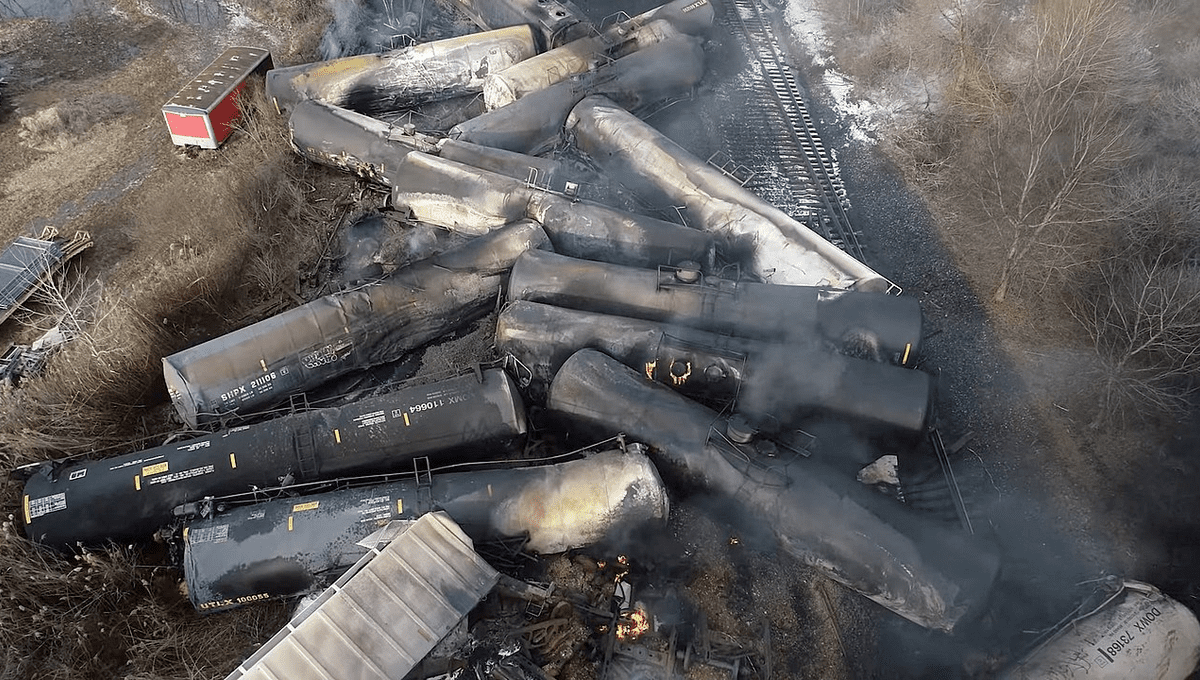
On February 3, a train derailed in northern Ohio, causing the evacuation of a town and threatening some of the most important waterways in North America. The story has attracted surprisingly little coverage, but that might be starting to change after images of the event have built traction on social media.
On seeing reports of an explosion in East Palestine, people might imagine it refers to conflict in the Middle East. Instead, the affected area centers on a former industrial town of 4,800 people situated between Cleveland and Pittsburgh.
The derailment, since blamed on an axle in a single car, affected around 50 of the train’s 141 loaded cars, of which 20 were carrying hazardous materials. Fourteen of these cars carried (mono) vinyl chloride, five of which crashed, making it the most important contributor to the dangers.
The chemicals released in the derailment burned for three days, and residents within a 1.6-kilometer (1-mile) radius of the wreck were evacuated from fears of a catastrophic tanker failure. Eventually, a controlled release and burn was conducted to prevent a catastrophic explosion.
A train derailment last week sparked a major chemical fire that is a danger to human life. Please start pic.twitter.com/N3gVy9PNht… https://t.co/nQjYydEbCP
Mono vinyl chloride (H2C=CHCl) is used to produce the more familiar polyvinyl chloride (PVC). One of the world’s most heavily used plastics, PVC with additives is used in piping, electrical cables, plastic bottles, and credit cards, ensuring most of the world has contact with it daily.
PVC may be a hazard to wildlife when it gets into waterways and there are health concerns about the widely added plasticizers, but neither of these would cause mass evacuations or fears for millions of people’s drinking water. Vinyl chloride that has yet to be converted to PVC, however, is much more of a hazard.
As a gas under atmospheric pressure, vinyl chloride is much harder to contain in an accident like this, and it is highly flammable.
The EPA lists vinyl chloride as a Class A “known human carcinogen”, whether through people eating fish that have bioaccumulated the chemical once it has reached waterways or inhaling it during manufacturing. Possible effects from inhalation include dizziness, headaches, and narcosis. Longer-term, lifetime exposure can cause liver disease as well as cancers of multiple organs.
Vinyl chloride is stored and transported under pressure to liquefy it. Although transportation devices are designed to be impact and heat-resistant, these measures failed in this case. On release, mono vinyl chloride forms a cloud with a density around twice that of air, keeping it low to the ground and hindering dispersal. It will explode at ordinary temperatures over a wide range of concentrations in air. When it burns, one of the products is hydrogen chloride, which can react with water vapor in the atmosphere to produce acid rain.
According to Norfolk Southern, the company responsible for the railway, the derailment also released butyl acrylate and benzene, both of which are also combustible and toxic. Other toxic chemicals that were being transported and may have been released into the environment include ethylhexyl acrylate and ethylene glycol monobutyl ether.
The accident has set off local fury, which has been intensified by the lack of national and international coverage. The arrest of a journalist attempting to cover responses to the fire has attracted condemnation even from the Ohio governor.
Locals are reporting dead fish in nearby streams and chemical smells well away from the derailment site. Norfolk Southern has offered the town $25,000 in compensation but is facing multiple lawsuits.
IFLScience attempted to contact the EPA for comment, but have not received a response at the time of publication.
Source Link: What Is Vinyl Chloride, The Chemical That Caused Ohio’s Immense Explosion?